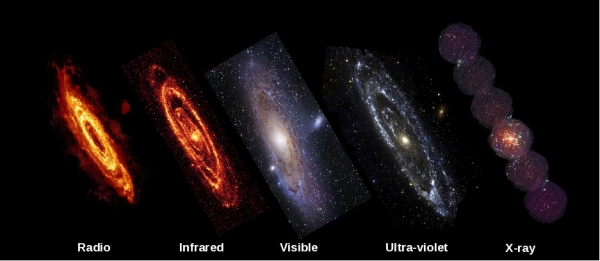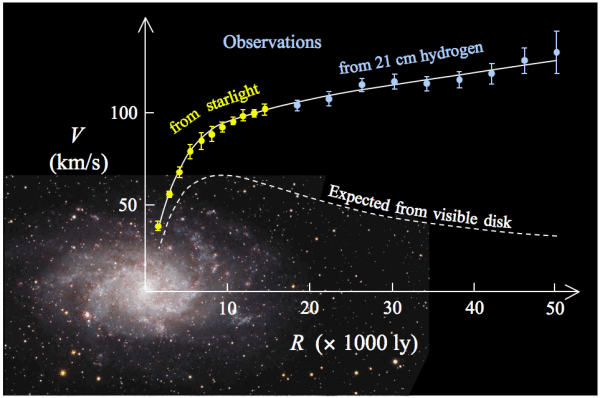“The discrepancy between what was expected and what has been observed has grown over the years, and we’re straining harder and harder to fill the gap.” -Jeremiah Ostriker
If you look at the stars in a galaxy -- and then at all the different wavelengths of light that there are -- you'd think you can do a good job of reconstructing its mass, and where it's located.
Makes sense, right? Only then, if you take those observations and compare them to how the stars within the galaxy actually move, you'd be shocked to find that what you see isn't what you get!
You might think to invoke dark matter, or you might seek to change the laws of gravity, but there's a brilliant observational test we can make to tell the two scenarios apart. And for the first time, on the scales of an individual galaxy, we've seen the dark matter explanation emerge as the only one that makes sense. Go read the whole story.



Quantum gravity provides a better explanation.
http://www.worldscientific.com/doi/abs/10.1142/S0219887815500425
The issue with this article is epitomized by this Einstein quote: "the energy of the gravitational field shall act gravitatively in the same way as any other kind of energy". It isn't matter per se that causes gravity. Or mass. It's a concentration of energy. The energy of the gravitational field is "spatial energy". It isn't made up of particles. And when it’s inhomogeneous, it has a mass-equivalence and a gravitational effect. We're confident that the universe has expanded a thousandfold since the CMBR, like the raisin-cake analogy: space expands between the galaxies but not within. So we can be fairly sure the spatial energy isn’t homogeneous. So it has a mass equivalence and a gravitational effect. So every galaxy is sitting in its very own halo of “dark matter”. Only it isn’t made of particles. It’s just inhomogeneous space. Which is what a gravitational field is. Space is dark, it has its vacuum energy, and there’s a lot of it about.
Meh, I claim a false dichotomy logic error. There could be any number of reasons we don't understand this observation. It doesn't have to be one (dark matter) or the other (law of gravity is wrong).
The one thing I've never understood is how you can infer the mass of a galaxy from its light.
Simply put, if you have two stars of one solar mass, or if you have one star weighing two solar masses, their luminosities differ, the heavier star burns brighter than two solar luminosities. So simply looking at the total light emitted by a galaxy doesn't tell us much.
I doubt we're able to observe every single star in a far off galaxy individually, so we must use some kind of assumptions about the mass distribution of stars in a galaxy. It sounds to me like this could potentially introduce huge error in the mass measurement, so how do we know for certain there's a mass discrepancy at all?
All of this assumes that natural laws don't evolve over time. Are there any indications in the data that the results seen depend on distance (time), or can the data we have rule that out?
Spectrometry, I imagine. You're not just measuring total brightness, you're looking at the spectra of light emitted from sources within the galaxy and using that to deconvolute the signal. It may not give you individual object resolution but maybe you can get ratios of the amounts of various different classes of stellar objects.
I would like to draw your attention to the website:
http://universum2.webnode.cz/
where is in the new Appendix 4 named "Explanation ot the shape of galaxy rotation curves" (at the end of the there published article) shown the real cause of differential rotation of galaxies. I hope, you will find it interesting related to the question, of "Dark Matter"..
I would like to draw your attention to the website:
http://universum2.webnode.cz/
where is in Appendix 4 named "Explanation ot the shape of galaxy rotation curves" shown the real cause of differential rotation of galaxies.
Is there a correlation between visible matter and dark matter?
For example, I just read that Andromeda is bigger than the Milky Way and yet the Milky Way is twice as massive.
What explains the difference in dark matter distribution?
Thanks
@Ragtag: see my comment #1. If one galaxy was older than another, the space it's sitting in would have a higher energy-density, because it hasn't expanded as much. This spatial energy has a mass-equivalence and a gravitational effect. Now google on Milky Way galaxy age. At the top of the list there's a box that says 13.2 billion years. Now google on Andromeda galaxy age and again there's a box at the top. It says 9 billion years.
@John
Thanks John